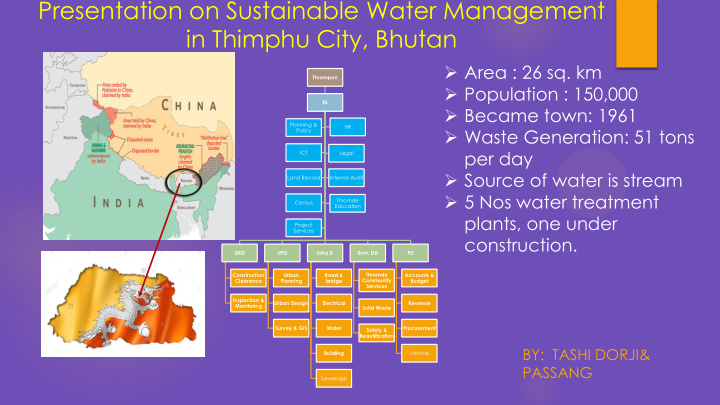



Presentation on Sustainable Water Management in Thimphu City, Bhutan Area : 26 sq. km Thrompon Population : 150,000 ES Became town: 1961 Planning & HR Waste Generation: 51 tons Policy per day ICT Legal Source of water is stream Land Record Internal Audit 5 Nos water treatment Thromde Census Education plants, one under Project Services construction. DRD UPD Infra D Envt. DD FD Thromde Construction Urban Road & Accounts & Clearance Planning bridge Community Budget Services Inspection & Urban Design Electrical Revenue Monitoring Solid Waste Survey & GIS Water Procurement Safety & Beautification BY: TASHI DORJI& Building Vehicle PASSANG Sewerage
Problem Identification Lack of long-term drinking water supply master plan. 1. Unprecedented development and population growth. 2. Inability of the water supply infrastructure to cope with the 3. growing demand. Financial constraint and lack of adequate technical capacity to 4. develop water supply infrastructure. Lack of appropriate technology and technical capacity to 5. operate and maintain water supply systems. Intermittent water supply with high system loss. 6. Resulting in the shortage of drinking water shortage. 7. Goal is To ensure safe drinking water to protect consumer health.
Background of the Policy Project – South Thimphu Water Supply Scheme Goal : Provision of 24x7 reliable, safe and sustainable drinking water supply. Integration/networking with existing Systems. Project duration -18 months Funded by – Asian Development Bank Project Budget : Nu. 114.00M Target population is about 50,000 to 60,000 Main stakeholder of the Policy - Thimphu Residents Was planned and constructed to meet the demand of drinking water supply shortage.
Key issue of the project implementation Obstacles and difficulties of the Policy (Project): Land acquisition. E.g Acquisition of identified site for WTP • Easement for transmission pipeline. E.g raw water transmission passes • through private property. Forest/Environmental Clearance. E.g the location of water intake is • within the National Park. Interest and conflicts among Stake-holders: Interest: • Access to 24x7 safe and reliable drinking water supply in a sustainable manner to improve water and sanitation for Public health. (WHO Guideline BDWQS 2016) . Coordination with stakeholders •
Conflict: Water use priority as per water act 2011 • Favorable and unfavorable condition related to the Policy: • Favorable: Strong Political will. Strong support from the beneficiaries. Strong support from the Stakeholder. (MoWHS for Urban and water Sanitation, MoH, Is apex body for quality for both urban and Rural, NEC is Apex Body for Regulatory
Key strategies for success of the Project Your role in solving the problem Long-term drinking water master plan (draft) prepared. • Secure Funding source from the Bank. • Extension of distribution network including augmentation. • Important strategies or policy tools you have employed in the process Extensive consultation with the stakeholders. • Selection of appropriate technology to ensure sustainability. • Creative ideas and policy actions, new management techniques or technology used in the process. Networking of the new scheme with the existing systems to • integration/achieve equitable supply
Key strategies for success of the Project New Technology for water treatmet plant • How to persuade or to compromise different interest among stakeholder Divided project into different packages for simultaneous • implementation to ensure completion in time.
Lesson and Implications Missed: Adequate time to be allotted for project planning • Timely acquisition of land required for the project • Achieved: • Project planned successfully and under implementation • Land Acquired • Appropriate Technology selected for WTP • Environment Clearance obtained • Good strategies and policy tools that can be applied to similar cases Coordination with relevant stake holders • Selection of appropriate technology • Synchronization of implementation of project components • Policy recommendation for the project: Transfer of technologies and Capacity building to ensure sustainability of the project •
THANK YOU
Recommend
More recommend